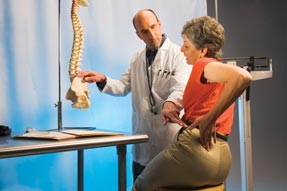Safe prescribing can lessen overdose risk
In what one commentator called an “appalling” finding, 90% of patients in a recent study admitted to a hospital with a prescription opioid overdose eventually received another opioid prescription##mdash;often from the same clinician. Efforts to improve safe prescribing hope to fix the problem.
By now, internists are well aware of the risks of opioids. The CDC reports that opioid analgesics accounted for 18,893 deaths in 2014 compared to 4,030 in 1999, and heroin deaths jumped from 1,960 to 10,574 during that same time period.
Yet a study published in January by Annals of Internal Medicine found that 90% of patients admitted to a hospital with a prescription opioid overdose eventually receive another opioid prescription—often from the same clinician.

The finding is “appalling,” said Jessica L. Gregg, MD, PhD, a physician at Providence Health Services in Portland, Ore., who wrote an editorial accompanying the Annals article.
“I couldn't believe it,” she said. “Then I thought about it some more and realized, ‘Of course that happens.’ I've probably done the same and I just don't know it.”
Fragmented care can make it difficult, if not impossible, for primary care physicians to know all the drugs a patient is taking or even whether the patient has been hospitalized with an overdose, but individual internists can also take steps to reduce the overdose risk of those in their care, experts said.
Parsing the problem
Part of the issue is time, or lack of it. “It takes a doctor 20 seconds to say yes to a prescription but 20 minutes to say no,” said Gavin Bart, MD, PhD, FACP, director of the division of addiction medicine at Hennepin County Medical Center in Minneapolis. “So when you're juggling complex medical disorders, the path of least resistance is opioid prescribing.”
It's not all physicians' fault, he said, but they need to do their part by better understanding how to use opioids, how to talk to patients about them, and how to recognize opiate use disorder.
Unfortunately, there's no algorithm to make that easy, said Daniel P. Alford, MD, MPH, FACP, associate professor of medicine and assistant dean of continuing medical education at Boston University School of Medicine.
“If you're looking for a ‘Tell me exactly what I need to do each time’ guideline, this is going to drive you crazy,” he said. “But if you're more of an art of medicine doctor and into individualizing care, then it's doable.”
In March, the CDC offered some advice in the form of recommendations to help physicians manage opioid use for chronic pain, which Dr. Alford called a “well-intentioned” starting point, especially when treating patients new to the medications. For example, the recommendations note that physicians should start with immediate-release and not extended-release/long-acting opioids, engage in practical discussions with patients not on opioids about risks and benefits, and coprescribe naloxone.
However, some of the recommendations don't go into enough detail, said Dr. Alford, who is also director of Boston University's Safe and Competent Opioid Prescribing Education (SCOPE of Pain) program. For example, the CDC recommends nonpharmacologic therapy (e.g., psychotherapy, social work, and physical therapy), but the recommendations don't discuss where patients can access such therapy or whether and how it is reimbursed.
“Most people who wrote the recommendations don't take care of patients, so they don't know the [payment issues],” said Charles Argoff, MD, a professor of neurology at Albany Medical College and director of the Albany Medical Center comprehensive pain center in New York. “So it's not practical from that point of view.”
Also, the CDC recommends setting treatment goals and considering how to discontinue therapy if benefits don't outweigh risks. However, they don't detail how to do that or how to determine what “meaningful improvement” means, Dr. Alford said.
Dr. Argoff noted, however, that just having the CDC weigh in sends a positive message.
“More people appreciate that there have to be certain checkpoints and checks and balances on the system. … It at least raises questions for us to start thinking about and take extra measures as we prescribe [opioids],” he said.
(ACP offered feedback on a draft version of the CDC guidelines and issued a statement of support after the final version was released.)
Managing expectations
A large part of the solution in working safely with opioids, alone and in conjunction with other drugs, is managing patients' expectations.
For example, patients who expect their pain score to drop from 10 to 0 often ask for greater doses. “It's not because they're addicted, it's because they're trying to get complete relief from their pain, which is probably never going to happen. … If that's the expectation then the patient will be completely dissatisfied with their treatment,” Dr. Alford said.
Physicians also need to do more than measure pain, said Dr. Gregg. Instead of focusing only on the pain scale, ask a patient, “How are you functioning?” she recommended, as well as other questions like “Are you more or less able to do the things you find meaningful? How is your thinking? Your sleep?”
Even relative improvement is a positive result. When Dr. Alford sees a new patient who has had some relief from recently prescribed opioids and is requesting a dose increase, he says, “Great! I am delighted that you are getting some relief … but I'm not going to consider increasing your dose for months. You are better off today on this dose than you were 2 weeks ago. It is time to focus on other therapies rather than increasing the opioid dose.” Dr. Alford explained he doesn't consider increasing the dose until he follows the patient for months to see if he or she can take it safely.
Patients are used to taking medications as needed, so doctors need to discuss why it's different with opioids. Explain that taking extra doses can be lethal and that taking more or greater doses means greater risk of side effects and smaller incremental benefits, Dr. Alford advised.
“Say, ‘I'm not saying it won't make you feel better, but the risk/benefit profile changes at higher doses because of a higher risk for harm including overdose. As your physician I'm constantly making that calculation,’” Dr. Alford said.
Likewise, patients who are used to getting refills without even a conversation should be informed of the importance of regular medication reviews, especially with medicines such as opioids. “Say, ‘I wouldn't be doing my job if I reflexively refilled your prescription opioids. All drugs have risks, and nowhere is this more the case than with opioids. We've got this wrong for so long and at great cost to public health,’” said G. Caleb Alexander, MD, co-director of the Johns Hopkins School of Public Health Center for Drug Safety and Effectiveness in Baltimore.
Warning signs
If a patient has worrisome behaviors, such as coming up short on a pill count or an unexpected urine drug test result, Dr. Alford suggested saying, “I believe you have terrible pain and that this opioid is helping you, but I need to keep you safe from the harmful effects of these medications, so we need to focus on treating your pain with something else and tapering your opioid.” If patients disagree, ask, “What did you hear me say?” to clarify any misunderstandings, he suggested.
If you see warning signs, tell the patient directly by saying, “I believe you may have opioid dependency,” Dr. Alexander said. In these situations he doesn't cut the patient off but instead gives a short-term prescription for a month or two. He also refers the patient for evaluation for opioid addiction or dependency and to a pain physician.
In addition to those who overuse opioids, another high-risk group for overdose is patients who take certain other medications concomitantly. A study of U.S. veterans published by The BMJ in June found a dose-dependent increased risk for drug overdose death among those taking both opioids and benzodiazepines. In addition, an article published in April in the American Journal of Public Health found that prescriptions for benzodiazepines (like diazepam or alprazolam) increased considerably (67%) between 1996 and 2013. During the same time, opioid analgesic prescribing also increased rapidly, and concomitant benzodiazepine use was common. The study authors found that opioids were involved in an estimated 75% of the overdose deaths from benzodiazepines. (On Aug. 31, the FDA announced that opioids and benzodiazepines must begin carrying a “black-box” warning detailing the serious risks of taking both types of drugs at the same time.)
The potential for opioids to interact with other drugs can take patients by surprise, said Marcus Bachhuber, MD, ACP Member, an internist at the Montefiore Medical Center/Albert Einstein College of Medicine in New York and the lead author on the American Journal of Public Health study.
“It's a tricky conversation because patients view medications differently: opioids for chronic pain, benzodiazepines for anxiety or insomnia,” he said. “Some people say, ‘I'm fine,’ so it's a matter of working with them to understand you're fine until you're not.”
First, physicians should explain what the interaction is and let patients know that combining opioids and benzodiazepines (and alcohol) can increase the risk of overdose, Dr. Bachhuber stressed. “I'm surprised at the number of patients who say that they did not know this,” he said.
Second, he said, he tries to determine the patient's understanding of overdose risk. “Often, patients think that overdoses only happen to people who are deliberately misusing the medications or who have a substance use disorder. That they are not ‘that type of person’ and so their risk is lower,” he said. “So I explain that overdose is something that can happen to any type of person.”
Finally, Dr. Bachhuber said, he lets the patient know about ways to reduce risk, including (but not limited to) avoiding alcohol, reducing the dose, and not taking more medication than prescribed. “For patients with clear safety issues such as very high opioid doses combined with benzodiazepines, I will lower the amount I prescribe, but the vast majority of patients are in a gray area where we can work with them to reduce risk,” he said.
Internists should also open up channels of communication with other physicians, such as oncologists. Finding out what else is going on medically can help deter unintentional overdoses, said Dr. Argoff. For example, if a physician gives a patient a fentanyl patch and that patient then gets an antifungal medicine from his podiatrist, there could be trouble. “The patient's serum fentanyl level may increase without the prescriber of the patch knowing as a result of the addition of the antifungal medicine,” he said. He added that clinicians and patients alike need to be vigilant about communicating with each other, including updating each other about planned and actual changes in medical regimens.
Teaming up for new solutions
In addition to communicating with colleagues to understand patients' medication use and risk, physicians need to collaborate with other caregivers to ameliorate pain, noted Dr. Gregg. When possible, the doctor together with the patient, physical therapist, cognitive behavioral therapist, and others should work together on interventions, she said.
Many patients won't balk at nonopioid suggestions, Dr. Bachhuber said. “A lot of people taking opioids know they're not safe, don't work well, and so are looking for alternatives,” he said. Some examples include nonopioid pain relievers, cognitive behavioral therapy, physical therapy, acupuncture, massage, and biofeedback; the best choice will vary by patient.
Dr. Bachhuber also noted that research may help change policy in the future, pointing to a 2014 study he coauthored in JAMA Internal Medicine finding that laws permitting medical use of marijuana were associated with a decrease in opioid overdose deaths and a 2016 study in Health Affairs finding that such laws were associated with reductions in claims for pain relievers and antianxiety medications.
For now, Dr. Alford stressed, just listening to your patients may reveal alternative solutions. “I had one patient whose pain lessened only when she went to a casino and played the slot machines,” he said. “It turns out distraction was the only thing that helped her pain relief.”





